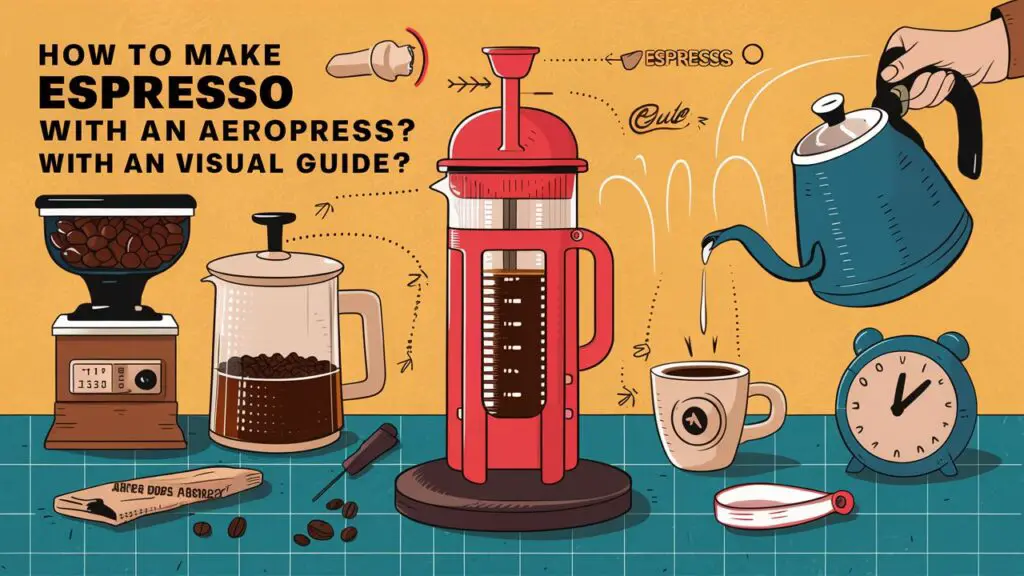As an Amazon Associate CoffeeXplore.com earns from qualifying purchases.
How to Make Espresso with an AeroPress: Detailed Guide
Ever craved a rich, concentrated coffee drink at home, but lacked the fancy espresso machine? You’re not alone. Many coffee lovers seek a convenient and budget-friendly alternative to traditional espresso brewing. The good news is, the AeroPress, a versatile brewing device, can come surprisingly close to creating espresso-like coffee.
While it won’t produce true espresso in the technical sense (due to the lack of high pressure achieved by an espresso machine), the AeroPress can deliver a strong, bold coffee concentrate that forms the perfect base for lattes, macchiatos, and more.
In this comprehensive guide, we’ll delve deep into the world of AeroPress espresso, equipping you with everything you need to know to brew delicious, concentrated coffee at home. We’ll cover the history and benefits of the AeroPress, explore the debate surrounding its ability to make true espresso, and provide a step-by-step guide to the brewing process.
But that’s not all! We’ll also share expert tips and tricks for perfecting your AeroPress espresso, explore exciting recipe variations, and guide you through the proper cleaning and maintenance of your AeroPress.
So, whether you’re a seasoned coffee aficionado or just starting your brewing journey, this guide will be your one-stop shop for mastering the art of AeroPress espresso.
What is an AeroPress?
The AeroPress, invented by Alan Adler in 1996, is a unique and innovative brewing device that utilizes a total immersion and pressure-based brewing method. Unlike traditional pour-over techniques, the AeroPress steeps coffee grounds in hot water for a short period before rapidly plunging a filter cap through the chamber, creating a clean and flavorful cup.
History of the AeroPress
Alan Adler, a Stanford University engineering professor, designed the AeroPress with the goal of creating a brewing method that was fast, easy to use, and produced a consistently delicious cup of coffee. His design addressed some of the limitations of traditional coffee makers, such as bitterness from over-extraction and a lengthy brewing process.
The AeroPress quickly gained popularity for its portability, convenience, and ability to produce a clean, full-bodied cup of coffee. Today, it’s a favorite among coffee enthusiasts worldwide, praised for its versatility and ability to brew a wide variety of coffee styles, including a concentrated coffee similar to espresso.
Why AeroPress?
The AeroPress offers several advantages over traditional brewing methods:
- Fast and Easy: Brewing with the AeroPress takes just minutes, making it a perfect choice for busy mornings.
- Portable: The lightweight and compact design makes the AeroPress ideal for travel or camping.
- Clean Cups: The paper filter system ensures a clean cup of coffee free of grit or sediment.
- Versatile: The AeroPress can be used to brew a variety of coffee styles, from strong and concentrated to lighter and more delicate.
- Durable: Made from BPA-free plastic, the AeroPress is built to last.
Can AeroPress Make Espresso?
This is a question that sparks debate among coffee enthusiasts. Technically, the AeroPress cannot produce true espresso because it doesn’t achieve the same level of pressure (around 9 bars) as a dedicated espresso machine. However, the AeroPress can create a concentrated coffee extract with a similar taste and mouthfeel to espresso, making it a fantastic alternative for home brewers.
Here’s a breakdown of the key differences:
| Feature | Espresso Machine | AeroPress |
|---|---|---|
| Pressure | 9 bars | Lower pressure (achieved through manual press) |
| Grind Size | Very fine | Fine grind |
| Water Temperature | Around 90°C (194°F) | Around 90°C (194°F) |
| Brewing Time | Short (25-30 seconds) | Slightly longer (around 30 seconds) |
| Coffee Yield | Concentrated shot (30-60 ml) | Concentrated extract (50-80 ml) |
While the AeroPress coffee may not be identical to true espresso in every way, it offers a robust and flavorful alternative that can be used to create delicious espresso-based drinks at home.
Preparing for AeroPress Espresso

Before you dive into brewing, it’s essential to gather the necessary equipment and ingredients.
What You’ll Need:
- AeroPress brewer
- AeroPress filter (paper or metal)
- Coffee grinder
- Scale (optional, but helpful for consistent results)
- Timer
- Kettle
- Mug
- High-quality espresso roast coffee beans
- Spoon for stirring
Choosing the Right Coffee Beans
When it comes to AeroPress espresso, selecting the right coffee beans is crucial for achieving a delicious and concentrated brew. Here’s what you need to know:
- Roast: Opt for espresso roast coffee beans. These beans are roasted darker than regular drip coffee beans, resulting in a bolder flavor profile with lower acidity. Darker roasts also tend to have a higher oil content, which can contribute to a richer crema (the foamy layer on top of espresso) when using the AeroPress.
- Freshness: As with all coffee brewing methods, freshness is key. Choose freshly roasted beans for the best flavor and aroma. Aim for beans roasted within the past two weeks for optimal results.
- Grind: You’ll need a fine grind for AeroPress espresso, similar to the consistency of table salt. If your grind is too coarse, the coffee will extract weakly, resulting in a thin and sour brew. Conversely, a grind that’s too fine can lead to over-extraction and bitterness.
Pro Tip: If you don’t have a grinder, you can purchase pre-ground espresso beans. However, for the freshest and most flavorful coffee, grinding your own beans is always recommended.
Step-by-Step Guide to Making AeroPress Espresso
Now that you have everything you need, let’s walk through the brewing process:
- Grind your coffee beans: Use the fine grind setting mentioned earlier. Aim for 17-20 grams of coffee for a single serving of AeroPress espresso.
- Heat your water: Heat fresh, filtered water to just below boiling (around 90°C or 194°F).
- Prepare the AeroPress: Place a filter in the AeroPress filter cap and pre-wet it with hot water to remove any paper taste. Discard the rinse water.
- Add coffee grounds: Add the measured coffee grounds to the AeroPress chamber.
- Bloom: Pour a small amount (around 30 grams) of hot water over the grounds and stir gently to ensure all grounds are saturated. Let the coffee bloom for 30 seconds. This allows the CO2 to release, resulting in a more even extraction.
- Fill and Press: Pour the remaining hot water into the AeroPress chamber, aiming to fill it just below the top. Stir briefly, then place the plunger on top. Press down firmly and slowly with steady pressure until you hear a hissing sound. This indicates that all the water has passed through the coffee grounds.
- Enjoy! Remove the AeroPress from the mug and discard the spent coffee grounds. You’ve now brewed a concentrated coffee extract similar to espresso.
Tips:
- Experiment with the coffee-to-water ratio to find your sweet spot. A good starting point is a 1:8 ratio (1 gram of coffee for 8 grams of water).
- The brewing time can also be adjusted to your taste. A longer brew time will result in a stronger and more bitter coffee.
- If you’re using a metal filter, you may need to adjust your grind size or brewing time slightly for optimal results.
Tips and Tricks for Perfect AeroPress Espresso
Here are some additional tips to help you elevate your AeroPress espresso game:
- Use a scale for consistent results. Measuring your coffee and water will ensure a balanced and repeatable brew.
- Preheat your mug. A warm mug will help maintain the temperature of your espresso.
- Experiment with different water temperatures. Depending on your roast and taste preferences, you may find that slightly cooler or hotter water produces a better cup.
- Try the inverted method. Some coffee enthusiasts swear by the inverted method, which involves brewing the coffee upside down before flipping it onto the mug. This method can potentially lead to a cleaner cup and more crema.
- Clean your AeroPress regularly. This will help prevent build-up and ensure optimal performance.
Variations of AeroPress Espresso Drinks
The beauty of AeroPress espresso is its versatility. You can use it as a base for a variety of delicious coffee drinks:
- Americano: Add hot water to your AeroPress espresso to create a lighter and more diluted coffee drink similar to Americano.
- Latte: Combine your AeroPress espresso with steamed milk for a creamy and comforting latte.
- Cappuccino: Add a dollop of frothed milk on top of your AeroPress espresso for a classic cappuccino.
- Mocha: For a decadent treat, add chocolate syrup or melted chocolate to your latte or cappuccino made with AeroPress espresso.
With a little creativity, you can explore endless possibilities and create your own signature coffee drinks at home.
Cleaning and Maintenance of AeroPress
Proper cleaning and maintenance will ensure your AeroPress lasts for years to come. Here’s what you need to do:
- After each use, disassemble the AeroPress and rinse all the components with hot water. You can also use a mild dish soap if needed.
- Periodically, you may want to deep clean your AeroPress by soaking the chamber and filter cap in a solution of baking soda and water. This will help remove any coffee oils or residue that can build up over time.
- Allow all components to dry completely before reassembling the AeroPress.
- It’s also recommended to clean the plunger regularly. Remove the rubber seal from the plunger and rinse it thoroughly. You can also replace the rubber seal periodically to ensure a proper fit and prevent leaks.
By following these simple cleaning and maintenance tips, you’ll keep your AeroPress in top condition for years of delicious coffee brewing.
People Also Asked
Here are some of the most common questions people have about making espresso with an AeroPress:
1. Can I use pre-ground coffee for AeroPress espresso?
Yes, you can use pre-ground coffee for AeroPress espresso. However, for the freshest and most flavorful coffee, grinding your own beans is always recommended. Pre-ground coffee loses its flavor and aroma quickly, so it’s best to use it within a day or two of grinding.
2. How much crema will I get from AeroPress espresso?
The amount of crema you get from AeroPress espresso will depend on several factors, including your roast, grind size, and brewing technique. You may get a thin layer of crema, but it won’t be as thick and rich as what you get from a traditional espresso machine. However, the crema can still add a touch of visual appeal and enhance the overall coffee experience.
3. Is AeroPress espresso as strong as real espresso?
AeroPress espresso can be quite strong and concentrated, but it may not be as strong as true espresso in terms of caffeine content. This is because espresso machines use higher pressure to extract more caffeine from the coffee grounds. However, the AeroPress espresso can still deliver a powerful and bold coffee experience.
Conclusion
The AeroPress is a versatile and user-friendly brewing device that can be a great option for creating espresso-like coffee at home. While it may not be a true espresso replacement in the technical sense, it can produce a delicious and concentrated coffee extract that forms the perfect base for lattes, macchiatos, and more.
With the help of this comprehensive guide, you’re now equipped with the knowledge and techniques to brew amazing AeroPress espresso. So, grab your AeroPress, experiment with different brewing methods and recipes, and discover the world of delicious coffee possibilities!




